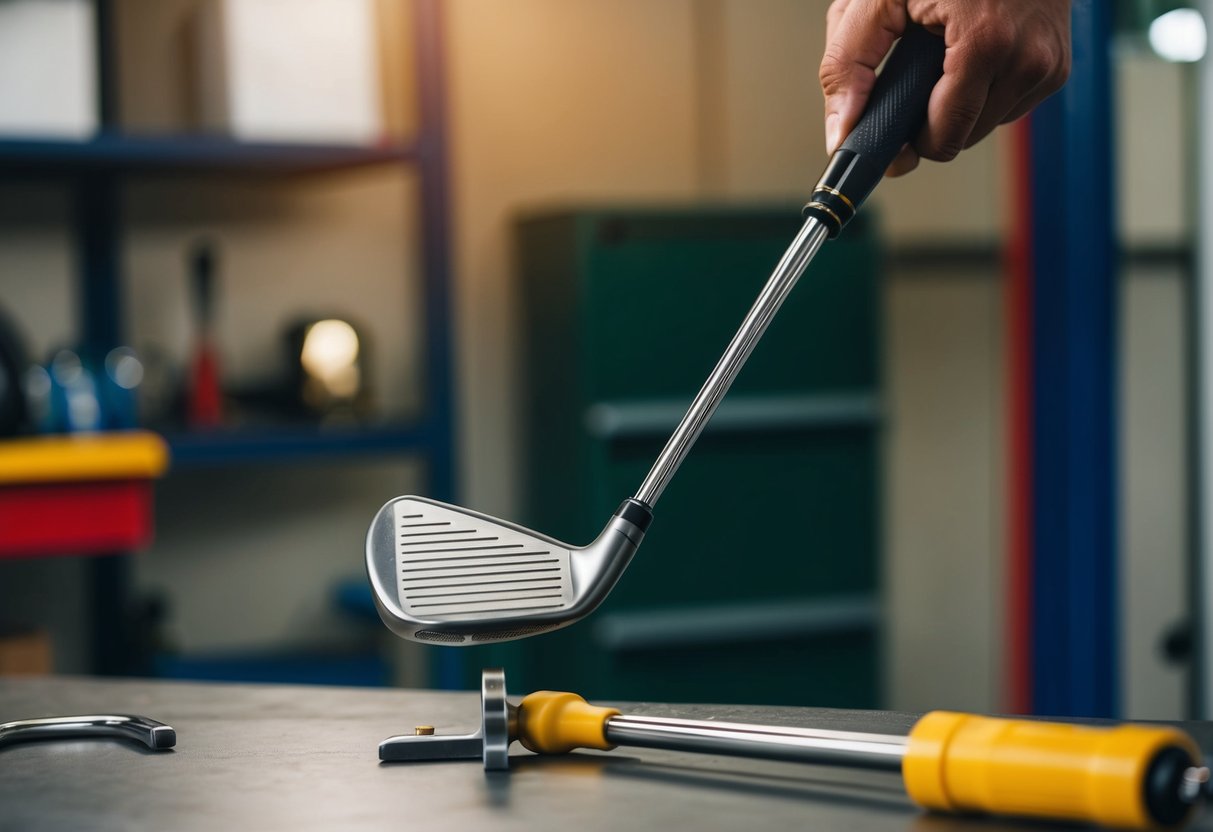Check out our golf rangefinders by Vovex to elevate your game!
Golf enthusiasts often find themselves seeking ways to improve their game. One effective method is extending golf clubs to better suit your height and swing style. Extending golf clubs can enhance comfort, accuracy, and overall performance on the course.
We've seen many golfers struggle with ill-fitting clubs, leading to inconsistent shots and frustration. By adjusting club length, players can achieve a more natural stance and smoother swing. This simple modification can make a significant difference in your golf experience.
In this post, we'll guide you through the process of extending golf clubs. Whether you're a seasoned pro or a weekend warrior, you'll discover how this technique can elevate your game and boost your confidence on the greens.
Key Takeaways
- Extending golf clubs can significantly improve comfort and performance
- Proper measurements and tools are essential for successful club extension
- Regular maintenance ensures extended clubs maintain their effectiveness over time
Understanding Club Extension
Golf club extension can significantly impact a player's performance and comfort on the course. By adjusting club length, golfers can optimize their swing and address various physical or technical issues.
Reasons for Extending Golf Clubs
Height is a primary factor in club extension. Taller players often benefit from longer clubs to maintain proper posture and swing mechanics. We've seen many golfers improve their game simply by matching club length to their body type.
Physical limitations can also necessitate club extension. Players with back problems or limited flexibility may find extended clubs help them maintain a more upright stance, reducing strain.
Some golfers extend their clubs to alter ball flight. Longer clubs can increase swing arc and clubhead speed, potentially resulting in greater distance. This modification is particularly popular among players looking to add yards to their drives.
Benefits of Proper Club Length
Correct club length enhances swing consistency. When clubs fit properly, we're able to maintain better posture and alignment throughout our swing. This leads to more accurate shots and improved overall performance.
Comfort is another key advantage. Well-fitted clubs reduce strain on the body, allowing for longer practice sessions and more enjoyable rounds. We've found that golfers with properly extended clubs often report less fatigue after playing.
Extended clubs can boost confidence. When we feel comfortable with our equipment, we tend to swing more freely and confidently. This mental edge can translate to lower scores and a more positive on-course experience.
Customized club length also helps address specific swing flaws. For instance, extending the shaft can help golfers who tend to slice the ball by promoting a more inside-out swing path.
Tools and Materials
Extending golf clubs requires specific tools and materials to ensure a proper and safe modification. We'll cover the essential equipment and supplies needed for this project.
Required Extension Tools
A shaft extractor is crucial for removing the existing shaft without damaging the clubhead. We recommend using a heat gun to soften the epoxy bonding the shaft to the hosel. A shaft saw or tube cutter helps trim the extension to the correct length.
A vise with rubber-coated jaws securely holds the club during the extension process. Sandpaper in various grits is necessary for smoothing the cut edges and preparing surfaces for bonding. We also use a cleaning solvent to remove any debris or oils from the surfaces.
Selecting the Right Supplies
Shaft extensions come in various materials, including graphite and steel. We choose extensions that match the original shaft's material and flex. High-quality two-part epoxy ensures a strong bond between the extension and existing shaft.
Grip tape is essential for securing the new grip. We select grips that match the player's preferences in size and texture. A grip solvent helps with easy installation and removal of grips.
Ferrules, small pieces that cover the joint between the shaft and clubhead, add a professional finishing touch. We always keep extra ferrules on hand in case of damage during the process.
Determining the Correct Extension Length
Extending golf clubs requires precision to maintain optimal performance. The right extension length depends on your height, arm length, and swing characteristics.
Measuring Your Current Clubs
We start by measuring your current clubs. Place the club in your normal address position, with the sole flat on the ground. Measure from the ground to the top of the grip. This gives us your current club length.
Next, we assess your wrist-to-floor measurement. Stand upright with your arms relaxed at your sides. Measure from your wrist crease to the floor. This helps determine if you need longer or shorter clubs.
Compare these measurements to standard club lengths. If there's a significant difference, you might benefit from extensions.
Custom Fitting Basics
A professional fitting session provides the most accurate results. We use launch monitors and swing analysis tools to evaluate your swing dynamics.
Key factors we consider:
- Swing speed
- Ball flight patterns
- Impact position on the clubface
We may have you hit shots with clubs of varying lengths. This helps us pinpoint the ideal extension length for your swing.
Remember, small changes can have big effects. Even a 1/4 inch extension can alter your ball flight and accuracy. We recommend incremental adjustments to find your sweet spot.
The Extension Process
Extending golf clubs requires precision and the right tools. We'll walk you through the key steps to successfully lengthen your clubs for improved performance on the course.
Preparing the Club for Extension
First, we remove the grip from the club shaft. A sharp utility knife helps cut through the old grip tape. We then clean the exposed shaft thoroughly with solvent to remove any residue.
Measuring is crucial. We determine the desired extension length, typically 1/2 inch to 2 inches. It's important to consider how this will affect the club's swing weight and overall feel.
We roughen the top portion of the shaft with sandpaper. This creates a better surface for the extension to adhere to.
Attaching the Extension
We select an extension plug that matches the shaft's inner diameter. Epoxy is applied to both the inside of the shaft and the plug.
Carefully, we insert the plug into the shaft. It's vital to align it properly to maintain the club's straightness.
We wipe away any excess epoxy immediately. The club is then set aside to allow the adhesive to cure fully, usually 24 hours.
Securing and Finishing the Extension
Once cured, we drill a small hole through the shaft and extension plug. This is for a pin that provides extra security.
We insert a steel pin and secure it with epoxy. After it sets, we file down any protruding parts of the pin for a smooth finish.
New grip tape is applied to the extended shaft. We then slide on a new grip, ensuring it's properly aligned with the clubface.
Lastly, we check the club's new overall length and adjust the lie angle if necessary. This ensures the extended club performs as intended on the course.
Aftercare and Maintenance
Proper care and regular check-ups are crucial for maintaining extended golf clubs. We'll explore essential maintenance practices and when to reassess club length.
Caring for Extended Clubs
Extended golf clubs require special attention. We recommend cleaning the grips and shafts after each use with mild soap and water. Dry them thoroughly to prevent rust or damage. Store clubs in a cool, dry place to avoid warping.
For graphite shafts, use a soft cloth to wipe them down. Avoid abrasive materials that could scratch the surface. Steel shafts can handle slightly more robust cleaning methods.
Check the epoxy joints regularly where extensions meet the original shaft. If you notice any looseness, have a professional re-epoxy the connection immediately.
When to Revisit Club Length
We suggest reassessing club length annually or when significant changes occur in your game. Growth spurts in younger players often necessitate adjustments. Weight gain or loss can also impact your ideal club length.
If you're experiencing consistent mishits or discomfort during swings, it might be time to reevaluate. Keep an eye out for changes in your posture or swing mechanics.
Consider scheduling a fitting with a professional every 12-18 months. They can assess whether your extended clubs still suit your current playing style and physical condition.
Frequently Asked Questions
Extending golf clubs involves some key considerations around tools, measurements, and potential impacts on your game. Let's address some common questions about the process.
Can I extend my golf clubs at home, and what tools will I need?
Yes, we can extend golf clubs at home with the right tools and know-how. We'll need a shaft extender, epoxy, a heat gun, sandpaper, and a grip kit. It's crucial to have a vice or clamp to hold the club steady during the process.
How do I determine the appropriate length to add to my golf clubs?
We determine the ideal extension length based on our height, arm length, and swing style. As a general rule, we add 1 inch for every 6 inches of height over 5'6". A professional fitting can provide more precise measurements.
Where can I find a professional service for extending the length of my golf clubs?
Many golf pro shops and sporting goods stores offer club extension services. We can also find specialized golf club fitters who provide expert lengthening services tailored to our individual needs.
Are there kits available for golf club extension, and how do they work?
Yes, golf club extension kits are available. These typically include shaft extenders, epoxy, and sometimes grips. We insert the extender into the shaft, secure it with epoxy, and then reattach the grip.
What are the advantages and potential downsides of lengthening a golf club shaft?
Lengthening clubs can improve our posture and increase swing arc, potentially leading to greater distance. On the flip side, it may affect the club's flex and weight distribution, which could impact our accuracy and consistency.
How do you calculate the proper golf club length for your height?
We start with a base measurement of 43 inches for a 5'6" golfer using a driver. For every inch of height difference, we adjust the club length by 0.5 inches. This gives us a rough estimate, which we can fine-tune based on our arm length and playing style.






